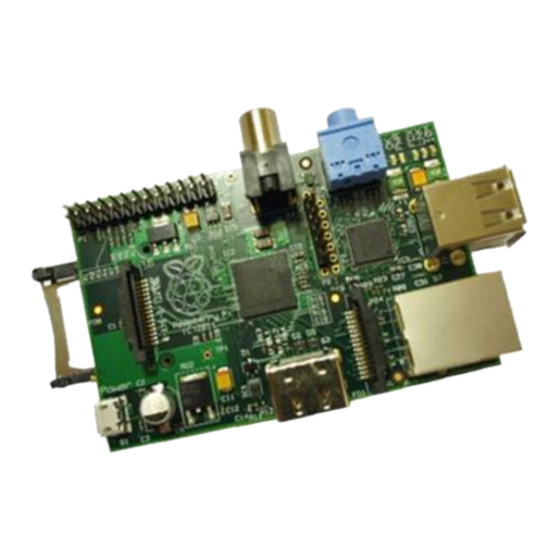Table of Contents
Advertisement
Quick Links
Advertisement
Table of Contents

Summary of Contents for Raspberry Pi Raspberry Pi A
- Page 1 Raspberry Pi Getting Started Guide RS Components Vsn 1.0 3/2012...
- Page 2 Raspberry Pi Getting Started Guide Page 2...
- Page 3 1.1. Extra Hardware You Will Need The Raspberry Pi board contains a processor and graphics chip, program memory (RAM) and various interfaces and connectors for external devices. Some of these devices are essential, others are optional. RPi operates in the same way as a standard PC, requiring a keyboard for command entry, a display unit and a power supply.
-
Page 4: Keyboard And Mouse
Note: The individual USB ports on a powered hub or a PC are usually rated to provide 500mA maximum. If you wish to use either of these as a power source then you will need a special cable which plugs into two ports providing a combined current capability of 1000mA. Raspberry Pi Getting Started Guide Page 4... -
Page 5: Additional Peripherals
If you plan on making use of the low-level interfaces available on the RPi, then ensure you have a suitable plug for the GPIO header pins. Also if you have a particular low-level project in mind, then ensure you design-in suitable protection circuits to keep your RPi safe. Raspberry Pi Getting Started Guide Page 5... -
Page 6: Serial Connection
2. Raspberry Pi Advanced Setup (Geeks only) 2.1. Finding hardware and setting up You'll need a preloaded SD card, USB keyboard, TV/Monitor (with HDMI/ DVI/ Composite/SCART input), and power supply (USB charger or a USB port from a powered USB Hub or another computer). -
Page 7: Sd Card Setup
Windows 7 or Vista users must download putty or a comparable terminal program. Users of XP and below can choose between using putty and Hyperterminal. 2.2.7. First Dialog If you get the prompt below, you are connected to the Raspberry Pi shell! prompt> # First command you might want try is "help": prompt>... - Page 8 When you get the number, round it DOWN. Thus, if you got C = 108.8 you'll be using 108 cylinders. =========================================================================== Expert command (m for help): c Number of cylinders (1-1048576, default 1011): 15 =========================================================================== Raspberry Pi Getting Started Guide Page 8...
- Page 9 Print and save the new partition records. =========================================================================== Command (m for help): p Disk /dev/sdc: 2021 MB, 2021654528 bytes 255 heads, 63 sectors/track, 245 cylinders Units = cylinders of 16065 * 512 = 8225280 bytes Raspberry Pi Getting Started Guide Page 9...
- Page 10 SD card into some Linux hosts will be based on that label. If there's no label, the new mount point will most likely be a long hstring, so assigning a label makes manual mounting on the host more convenient. Raspberry Pi Getting Started Guide Page 10...
- Page 11 You will need your SD card + reader and a Linux PC to use PiCard. After that, just plug the card into your Rpi. 2.7. Wire up your Raspberry Pi and power it up As explained in Section 1 2.8.
- Page 12 To read an SD-card image from the SD-card use: windd bs=1M if=\\?\Device\Harddisk1\Partition0 of=THE_IMAGE_READ –size Your disk name ^^^^^^^^^^^^^^^^^^^^^^^^^^^^^^^ 2.11. Copying an image to the SD Card BEWARE: DO THIS WRONG AND YOU MIGHT CORRUPT YOUR HARD DISK! Raspberry Pi Getting Started Guide Page 12...
- Page 13 The status of the respective ARM package repositories and their binary compatibility The possibility to build other software + its dependencies for the RPi from sources. For more guides and projects involving the Raspberry Pi, see RPi Projects http://elinux.org/RPi_Projects Raspberry Pi Getting Started Guide...





Need help?
Do you have a question about the Raspberry Pi A and is the answer not in the manual?
Questions and answers